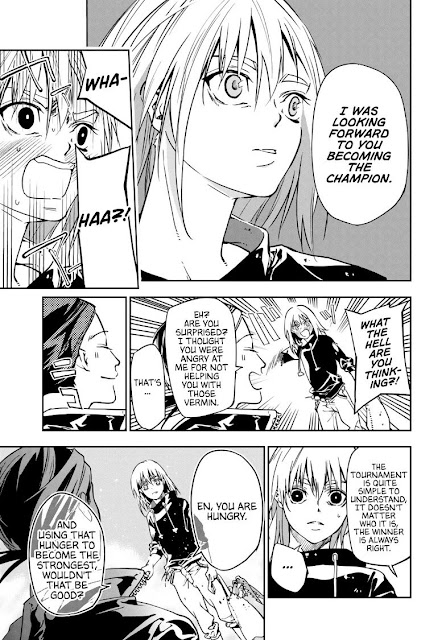Of the various English titles attributed to the Japanese manga ROKUDOU TOUSOU-KI, I think "Tournament of the Six Realms" most sums up the appeal of this shonen feature. I've seen the title "Battle of the Six Realms" more frequently online. But because TOURNAMENT was cut off by its original publisher at only sixteen episodes, there's no way to know if the main character was intended to engage in any activity beyond trying to win a fighting-tournament in his future-civilization. I saw one Reddit claim that the mangaka may have completed a few more chapters of TOURNAMENT around 2022, so I'll randomly assign the opening chapters with the date of 2021. Only the first two chapters meet my criteria as a myth-comic.
After author Serina Oda describes how future humanity fled a poisoned atmosphere and built a great city beneath the earth, we meet main character En, busy grubbing through garbage as he listens to public broadcasts, far above his head, about the impending Tournament. En's not quite alone, though. A somewhat older man named Sam, but calling himself "Sensei," shows up and remonstrates with the young fellow for blowing off school. En asserts that he's been exploring the city's underground trash heaps in search of "body modification" tech, which he can sell on the open market.
Though En loosely fantasizes about participating in the Tournament, he knows that he has no means to pay for the body modifications necessary for such high-level battles. Moreover, just as he scavenges amid discarded refuse and the dead bodies of unsuccessful combatants, local tough guys try to scavenge the fruits of his labors. One of the thieves even has some modification-tech in his body, though one presumes it's a low-level implant. The thug threatens En, but a weird fluctuation in the electrical system distracts the crooks, so that En escapes. Unbeknownst to the vagabond, a separate individual observes the unusual phenomenon.
A little later, En collapses from exhaustion in the midst of an upper-level crowd, and no one helps him but one stranger, whom readers should recognize from the earlier scene. The stranger doesn't introduce himself, but the two talk a bit, and En mentions, without any particular emphasis, that people told En he was born "from the corpse of a modified woman," implicitly someone who lost a battle in the Tournament and was consigned to the underground trash heap. The stranger turns the topic to the goal of competition in the Tournament, and seems to encourage the youth to enter, despite the fact that En can't afford any modifications. Then the stranger runs off.
Moments later, En runs into his only friend, the sensei Sam. En tells Sam how much the older man's friendship has meant to him. But to En's dismay, Sam sells him out. The sensei reveals that he was only waiting until En reached the age of 15, which was the ideal age on which to experiment on him.
However, En's extreme panic triggers something in his body, even though he's never technically undergone any modifications. En's unexplained power wrecks the lab and frees him from his bonds. However, Sam's assistants have modifications that give them arms like praying mantises. En fights them, unleashing a lightning attack and defeating the assistants.
Then Sam reveals that he too can manifest his inner mantis, and as the two of them fight, En runs low on power. Then there's a major concussion, apparently not from En or Sam, and the mysterious stranger shows up, demonstrating his own modification. And suddenly En puts all the pieces together. The stranger is none other than the current Tournament-champion, the famous Miroku, and he has saved En just to see "what you are capable of in the Tournament." And thanks to this quixotic support, En resolves to make the trash heap of his birth "the center of the world."
In the ensuing battle, Sam is defeated, and Miroku prepares to kill him. But En interferes. He argues that, despite the evil scientist's motives, Sam's false solicitude really helped En get through his torturous existence. So he spares Sam's life-- though En nevertheless punishes his bad friend by punching him out. Then, as a crowning touch, Miroku reveals that his main reason for following En around was that he'd observed the youth's peculiar powers, and so wondered if he Miroku might simply steal whatever tech En possessed. En concludes the two part story by telling his friendly enemy that he plans to steal Miroku's title as champion of the Tournament of the Six Realms.
The subsequent fourteen chapters do not reveal the source of En's powers, though the setup implies that somehow he acquired them from the body of his deceased mother. Some chapters broadly imply, though, that Miroku was more than just an exploiter like Sam. It's strongly implied that Miroku cleaves to the trope of the Sportsman Who Most Wants a Rival. The oldest use of the trope known to me is Richard Connell's 1924 short story "The Hounds of Zaroff," which became the basis of the 1932 MOST DANGEROUS GAME and countless imitations. Yet I harbor the unprovable opinion that Japanese pop culture may have embraced the trope far beyond the respective cultures of Europe or America.
The other fourteen stories are very good, though the symbolism is not elaborate enough for me to label any of them mythcomics. I hope Serina Oda gets the opportunity to continue En's exploits. But even if he (or she?) does not, En remains one of the more impressive examples of the "hero of low estate aiming for the stars."

















No comments:
Post a Comment